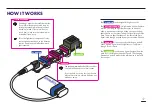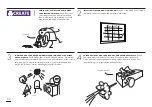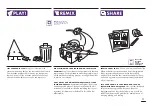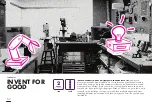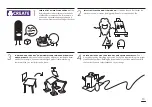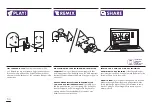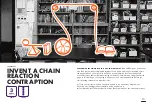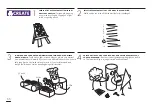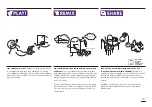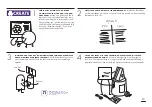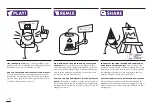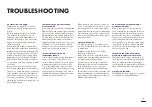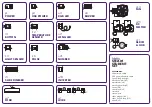
71
TROUBLESHOOTING
MY CIRCUIT ISN’T WORKING.
1)
Make sure your power Bit
TM
is on. You
should see a red LED illuminated on the
board.
2)
Try swapping in a new 9 volt battery.
Low batteries can cause a circuit to
mis behave. Bits
TM
have different power
demands. For example: a DC motor may
appear to not be working while a light
still shines brightly.
3)
Ensure the power cable is securely fas-
tened to both the battery and the power Bit.
4)
Make sure your Bits are arranged in the
proper order. Remember that you always
need a power Bit & power supply at the
beginning of each circuit, and an output
Bit at the end. If the last Bit in your chain is
an input, then it won’t do anything to affect
your circuit.
5)
Check your connections. Are all the
Bits securely snapped to each other? You
can also try gently wiping down the ends
of the bitSnaps with a soft cloth (like your
sleeve). Sometimes dust gets in the way
of a strong connection. Try unsnapping,
cleaning the bitSnaps, and snapping it all
back together again.
THE SENSITIVITY OF MY LIGHT SENSOR
KEEPS CHANGING.
Are you moving your circuit around between
different rooms and spaces? Light conditions
can vary quite a bit depending on many
different factors like the type of light you’re
working under, or the time of day (the sun
shines through the window at different
angles depending on what time it is). If your
light sensor is in a new environment (for
example, if the sun went down), you might
need to adjust the sensitivity again.
I’M HAVING TROUBLE WITH MY
TEMPERATURE SENSOR.
1)
If the signal coming into the temperature
sensor is less than ~50% power, the
sensor will be turned off (i.e. it won't pass
a temperature signal on to the next Bit.)
To turn the temperature sensor on, make
sure the Bits before it are sending a strong
enough signal. For example, if you have a
slide dimmer before the temperature sensor,
slide the dimmer all the way up.
2)
The power Bit can get warm with a lot
of use. If your temperature sensor is near
the warm power Bit, it may read a higher
temperature than the rest of your surroundings.
If this happens, try placing a wire between
the power and temperature sensor to give
them some space.
MY SERVO IS SHAKING.
1)
Check your battery. Try swapping in a
new one. Low batteries can cause the servo
to misbehave.
2)
Make sure the servo’s wire is firmly
connected to the board.
3)
The servo motor can only take so much
weight. If you have something attached to it,
you might need to lighten the load.
4)
If your servo is receiving a signal from
a light sensor Bit, the light conditions may
have had an effect on your servo. For
example, some fluorescent and LED light
fixtures flicker at a very high frequency and
cause the light sensor to send jittery signals.
If you suspect this problem, try moving to a
different light environment.
HOW CAN I CHANGE THE POSITION OF
MY MECHANICAL ARM?
Did you know that you can remove the
servo hub from the servo motor? To do this,
hold the black part of the servo motor and
pull the hub away from it. It should pop off.
Then you can rotate the position of the arm
to your liking and press the hub back on.
You may need to try this a few times to get
it just right. Be careful to align the little teeth
on the servo gear with the ridges inside the
hole on the servo hub.
I’M HAVING TROUBLE ATTACHING THE
WHEEL/MOTORMATE TO MY DC MOTOR.
The shaft of the DC motor and the holes in
the wheel and motorMate are all shaped
like a "D". Make sure that the flat edge of
the shaft on the DC motor aligns with the flat
edge of the hole in the wheel/motorMate.
STILL HAVING TROUBLE?
Visit littleBits.cc/faq or contact our customer
service team at support
@
littleBits.cc.
Summary of Contents for STEAM STUDENT SET
Page 2: ......
Page 4: ...2 WE INVE WORLD WANT TO ...
Page 5: ...3 NT THE WE O LIVE IN ...
Page 35: ...33 o25 DC MOTOR BUILD YOUR CIRCUIT 1 w1 WIRE p1 POWER o25 DC MOTOR i5 SLIDE DIMMER ...
Page 42: ...40 i16 PULSE p1 POWER o25 DC MOTOR o25 DC MOTOR BUILD YOUR CIRCUIT 1 ...
Page 49: ...47 i3 BUTTON p1 POWER o11 SERVO BUILD YOUR CIRCUIT 1 Attach the servo hub See pg 26 ...
Page 56: ...54 i16 PULSE i13 LIGHT SENSOR p1 POWER o6 BUZZER BUILD YOUR CIRCUIT 1 ...
Page 75: ......

